1998 CADILLAC ELDORADO wheel
[x] Cancel search: wheelPage 15 of 380
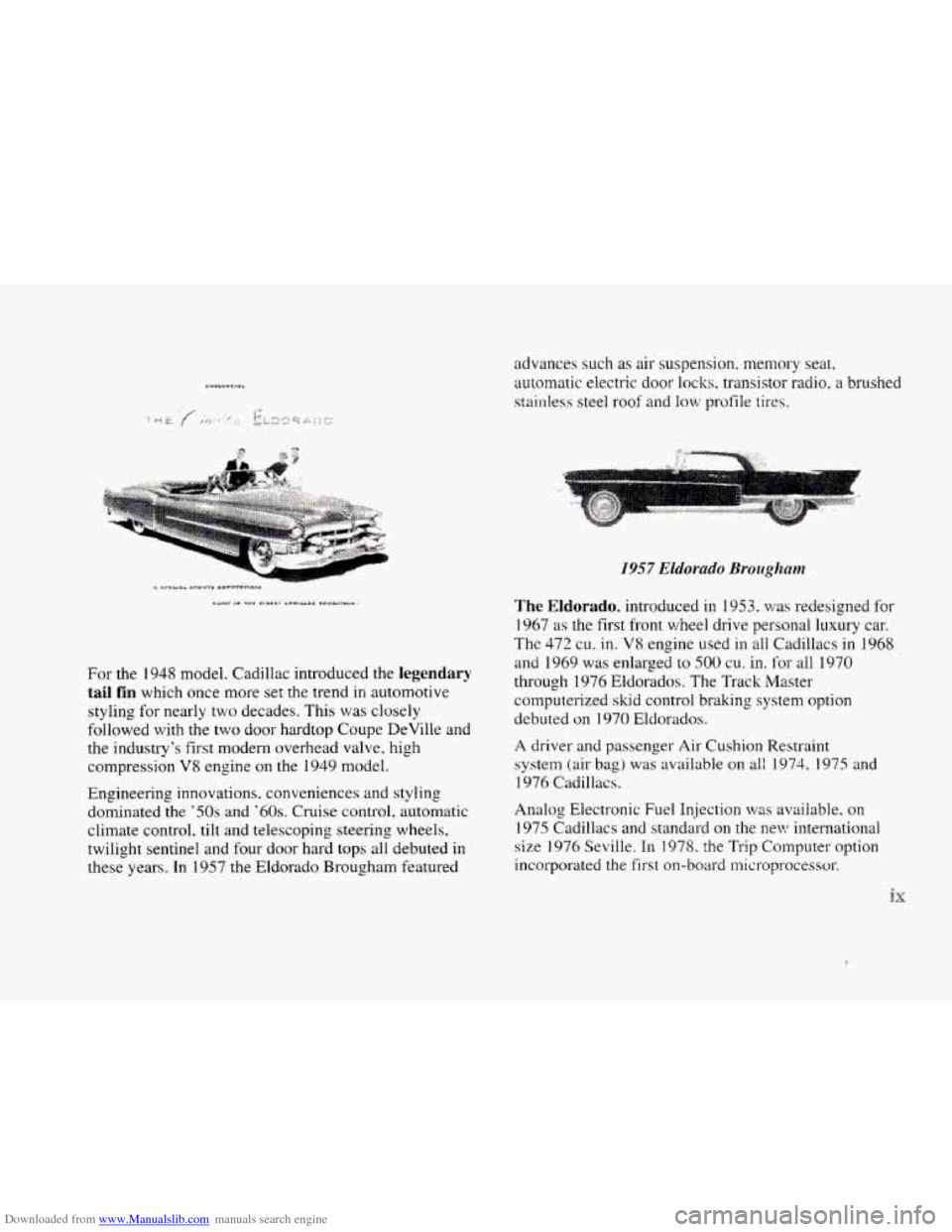
Downloaded from www.Manualslib.com manuals search engine For the 1948 model. Cadillac introduced the legendary
tail fin
which once more set the trend in automotive
styling
for nearly two decades. This was closely
followed with the two door hardtop Coupe DeVille and
the industry’s first modem overhead valve, high
compression
V8 engine on the 1949 model.
Engineering innovations. conveniences and styling
dominated
the ’50s and ‘60s. Cruise control, automatic
climate control.
tilt and telescoping steering wheels,
twilight sentinel and four door hard tops
all debuted in
these years. In 1957 the Eldorado Brougham featured advances
such as air suspension. memory seat,
automatic electric
door locks, transistor radio. a brushed
stainless steel roof and
low profile tires.
The Eldorado. introduced in 1953, wziS redesigned for
1967 as the first front wheel drive personal luxury car.
The
472 cu. in. V8.engine used in all Cadiilacs in 1968
and 1969 was enlarged to SO0 cu. in. for all 1970
through 1976 Eldorados. The
Track Master
computerized
skid control braking system option
debuted on
1970 Eldorados.
A driver and passenger Air Cushion Restraint
system (air bag) was available on
ali 1974. 1975 and
1976 Cadillacs.
Analog Electronic Fuel Injection
was available. on
1975 Cadillacs and standard on the new international
size 1976 Seville. In
1978. the Trip Computet. option
incorporated the first on-board microprocessor.
Page 16 of 380
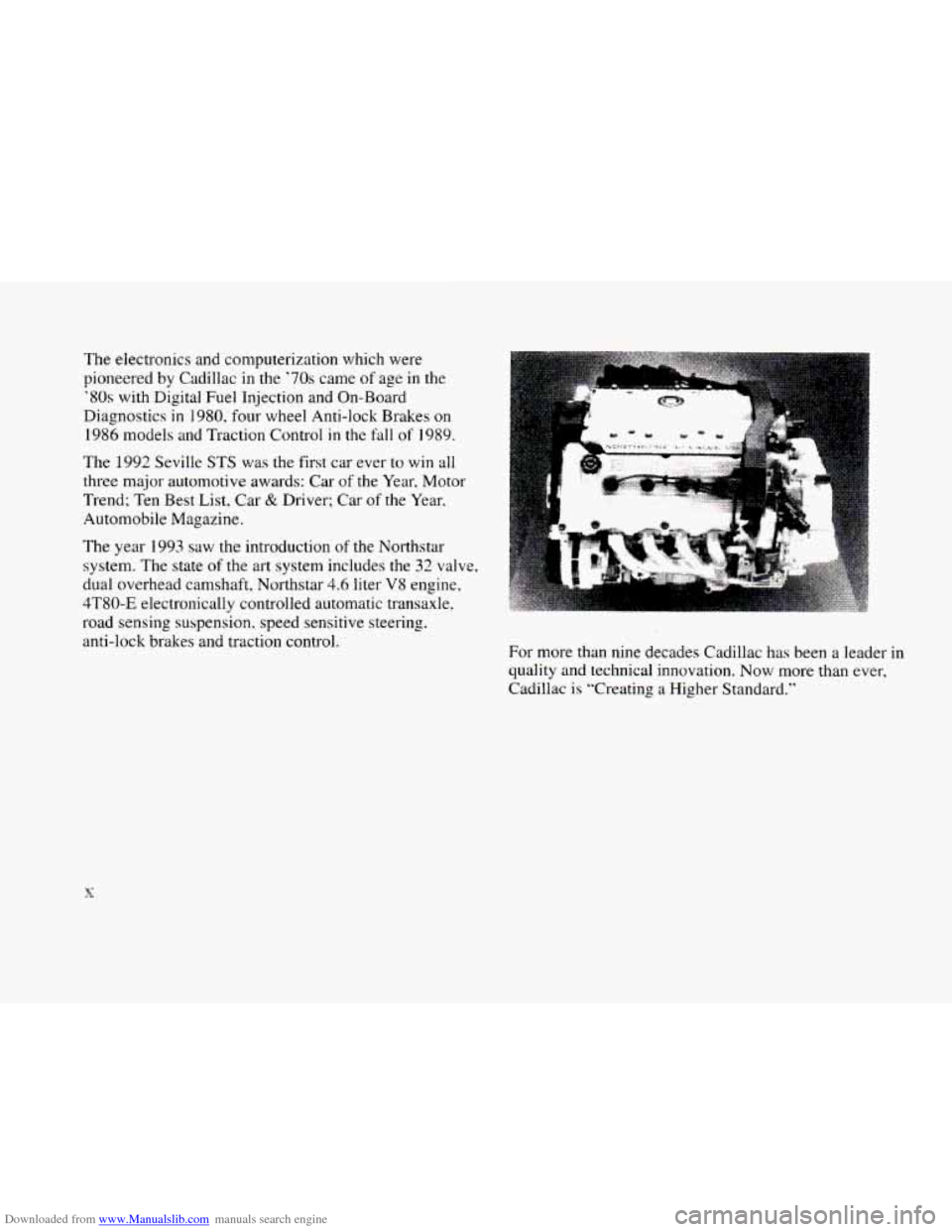
Downloaded from www.Manualslib.com manuals search engine The electronics and computerization which were
pioneered by Cadillac in the
’70s came of age in the
’80s with Digital Fuel Injection and On-Board
Diagnostics
in 1980. four wheel Anti-lock Brakes on
1986 models and Traction Control in the fdl of 1989.
The 1992 Seville STS was the first car ever to win all
three major automotive awards: Car
of the Year, Motor
Trend; Ten Best List, Car
& Driver; Car of the Year.
Automobile Magazine.
The year
1993 saw the introduction of the Northstar
system. The state
of the art system includes the 32 valve,
dual overhead camshaft, Northstar 4.6 liter V8 engine,
4T80-E electronically controlled automatic transaxle,
road sensing suspension, speed sensitive steering.
anti-lock brakes and traction control.
For more than nine decades Cadillac has been
a leader in
quality and technical innovation. Now more than ever,
Cadillac
is “Creating a Higher Standard.”
Page 28 of 380

Downloaded from www.Manualslib.com manuals search engine Why Safety Belts Work
When you ride in or on anything, you go as fast as
it goes.
i
k-
Take the simplest vehicle. Suppose it's just a seat
on wheels.
Put someone on it.
I
1-8
Page 42 of 380
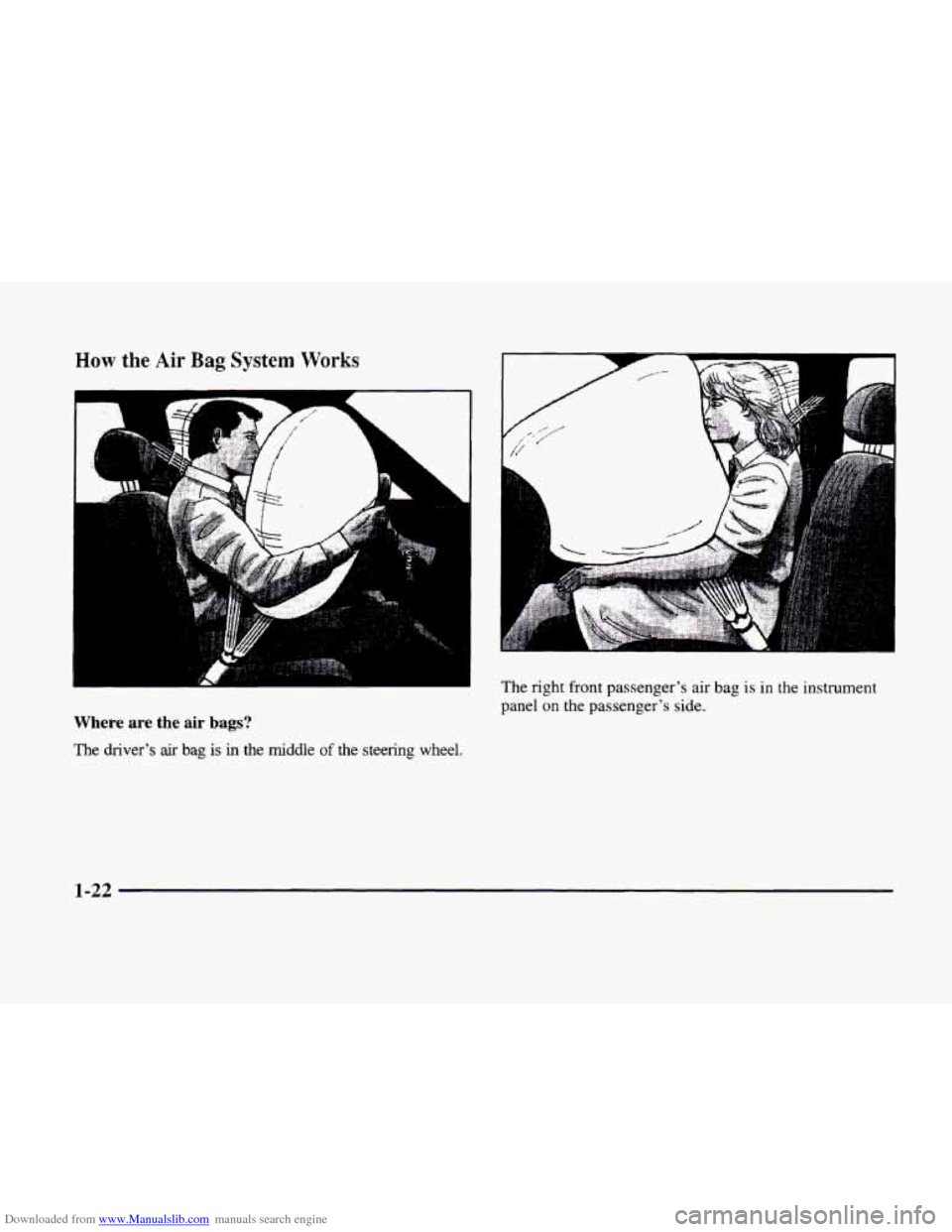
Downloaded from www.Manualslib.com manuals search engine HOW the Air Bag System Works
1
w.. ..
Where are the air bags?
The driver's air bag is in the middle of the steering wheel.
I
The right front passenger's air bag is in the instrument
panel
on the passenger's side.
1-22
Page 43 of 380
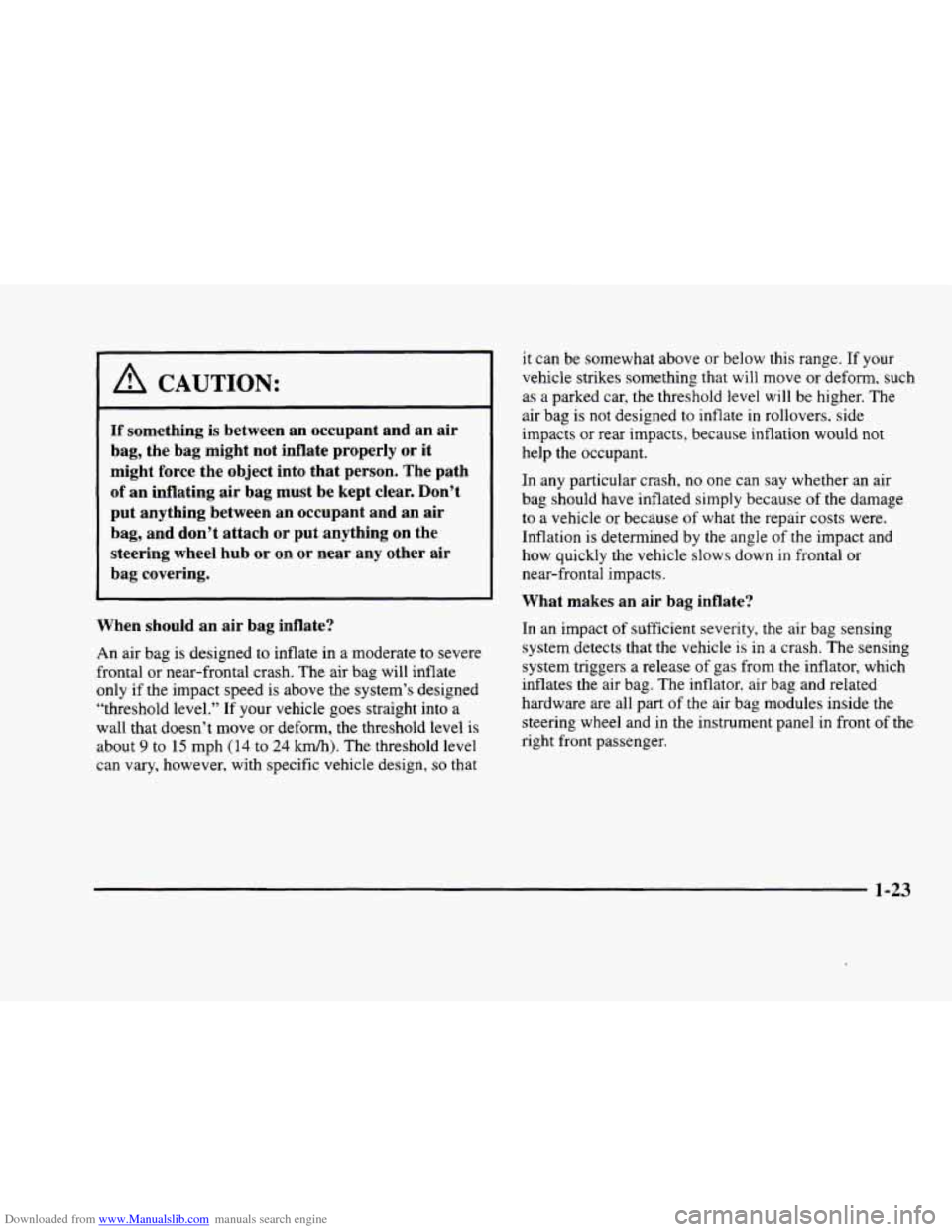
Downloaded from www.Manualslib.com manuals search engine 1 A CAUTION:
If something is between an occupant and an air
bag, the bag might not inflate properly
or it
might force the object into that person. The path
of an inflating air bag must be kept clear. Don’t
put anything between an occupant and an air
bag, and don’t attach
or put anything on the
steering wheel hub or
on or near any other air
bag covering.
~~
When should an air bag inflate?
An air bag is designed to inflate in a moderate to severe
frontal or near-frontal crash. The air bag will inflate
only if the impact speed
is above the system’s designed
“threshold level.” If your vehicle goes straight into a
wall that doesn’t move or deform, the threshold level is
about
9 to 15 mph (14 to 24 kmk). The threshold level
can vary, however, with specific vehicle design,
so that it can be
somewhat above or below this range. If your
vehicle strikes something that will move or deform, such
as a parked car, the threshold level will be higher. The
air bag is not designed to inflate in rollovers. side
impacts or rear impacts, because inflation would not
help the occupant.
In any particular crash, no one can say whether an air
bag should have inflated simply because of the damage
to a vehicle or because
of what the repair costs were.
Inflation is determined by the angle of the impact and
how quickly the vehicle slows down in frontal or
near-frontal impacts.
What makes an air bag inflate?
In an impact of sufficient severity, the air bag sensing
system detects that the vehicle is in a crash. The sensing
system triggers a release
of gas from the inflator, which
inflates the air bag. The inflator, air bag and related
hardware are all part of the air bag modules inside the
steering wheel and in the instrument panel in front
of the
right front passenger.
1-23
Page 44 of 380
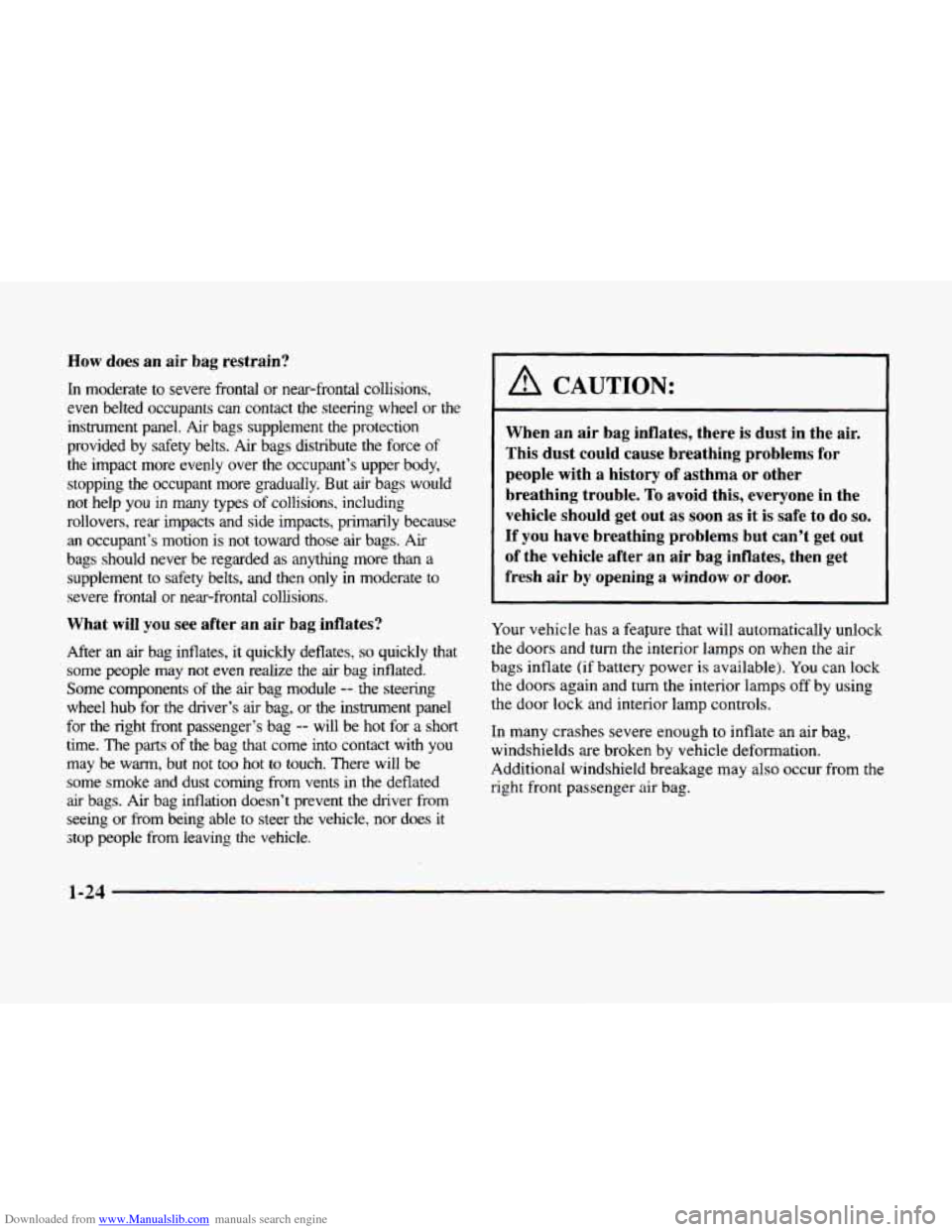
Downloaded from www.Manualslib.com manuals search engine How does an air bag restrain?
In moderate to severe frontal or near-frontal cobsions,
even belted occupants can contact the steering wheel or the
instrument panel.
Air bags supplement the protection
provided by safety belts. Air bags distribute the force
of
the impact more evenly over the occupant’s upper body,
stopping the occupant more gradually. But air bags
would
not help you in many types of collisions, including
rollovers, rear impacts and side impacts,
primarily because
an occupant’s motion is not toward those air bags. Air
bags should never be regarded as anything more than a
supplement to safety belts, and then
only in moderate to
severe frontal or near-frontal collisions.
What will you see after an air bag inflates?
After an air bag inflates, it quickly deflates, so quickly that
some people may not even realize the
air bag inflated.
Some components
of the air bag module -- the steering
wheel hub for the driver’s
air bag, or the instrument panel
for the right front passenger’s bag
-- will be hot for a short
time. The parts
of the bag that come into contact with you
may be warm, but not too
hot to touch. There will be
some smoke and dust coming from vents in the deflated
air bags. Air bag inflation doesn’t prevent the driver from
seeing
or from being able to steer the vehicle, nor does it
stop people from leaving the vehicle.
A CAUTION:
When an air bag inflates, there is dust in the air.
This dust could cause breathing problems
for
people with a history of asthma or other
breathing trouble. To avoid this, everyone in the
vehicle should get out as soon as it
is safe to do so.
If you have breathing problems but can’t get out
of the vehicle after an air bag inflates, then get
fresh air by opening a window or door.
Your vehicle has a feapre that will automatically unlock
the doors and turn the interior lamps on when the air
bags inflate (if battery power is available). You can lock
the doors again and turn the interior lamps off by using
the door lock and interior lamp controls.
In many crashes severe enough to inflate an air bag,
windshields are broken by vehicle deformation.
Additional windshield breakage may also occur from
the
right front passenger air bag.
1-24
Page 71 of 380

Downloaded from www.Manualslib.com manuals search engine Section 2 Features and Controls
Here you can learn about the many standard and optional features on your vehicle, and information on starting,
shifting and braking. Also explained are the instrument panel and the warning systems that tell you
if everything is
working properly
-- and what to do if you have a problem.
2-2
2-4
2-6
2-9
2- 13
2- 14
2-16
2- 17
2- 17
2-19
2-20
2-2
1
2-25
2-26
2-28
2-29 Keys
Door Locks
Remote Keyless Entry
(RKEj System
Trunk
Theft
Theft-Deterrent System (If Equipped)
PASS-Key(%
New Vehicle “Break-In”
Ignition Positions
Starting Your Engine
Engine Coolant Heater (If Equipped)
Automatic Transaxle Operation
Parking Brake
Shifting Into PARK (P)
Shifting Out of PARK (P)
Parking Over Things That
Burn
2-29
2-30
2-3 1
2-32
2-32
2-39
2-42
2-44
2-49
2-5
1
2-5 1
2-52
2-52
2-56
2-6
1
2-70
Engine Exhaust
Running
Your Engine While You‘re Parked
Windows
Tilt Wheel
Turn SignalMultifunction Lever
Exterior Lamps
Interior Lamps
Mirrors
Storage Compartments
Sun Visors
Cellular Telephone (Option)
Astroroof (Option)
Universal Transmitter (Option
j
Instrument Panel
Warning Lights, Gages and Indicators
Driver Information Center (DIC)
2-1
Page 83 of 380
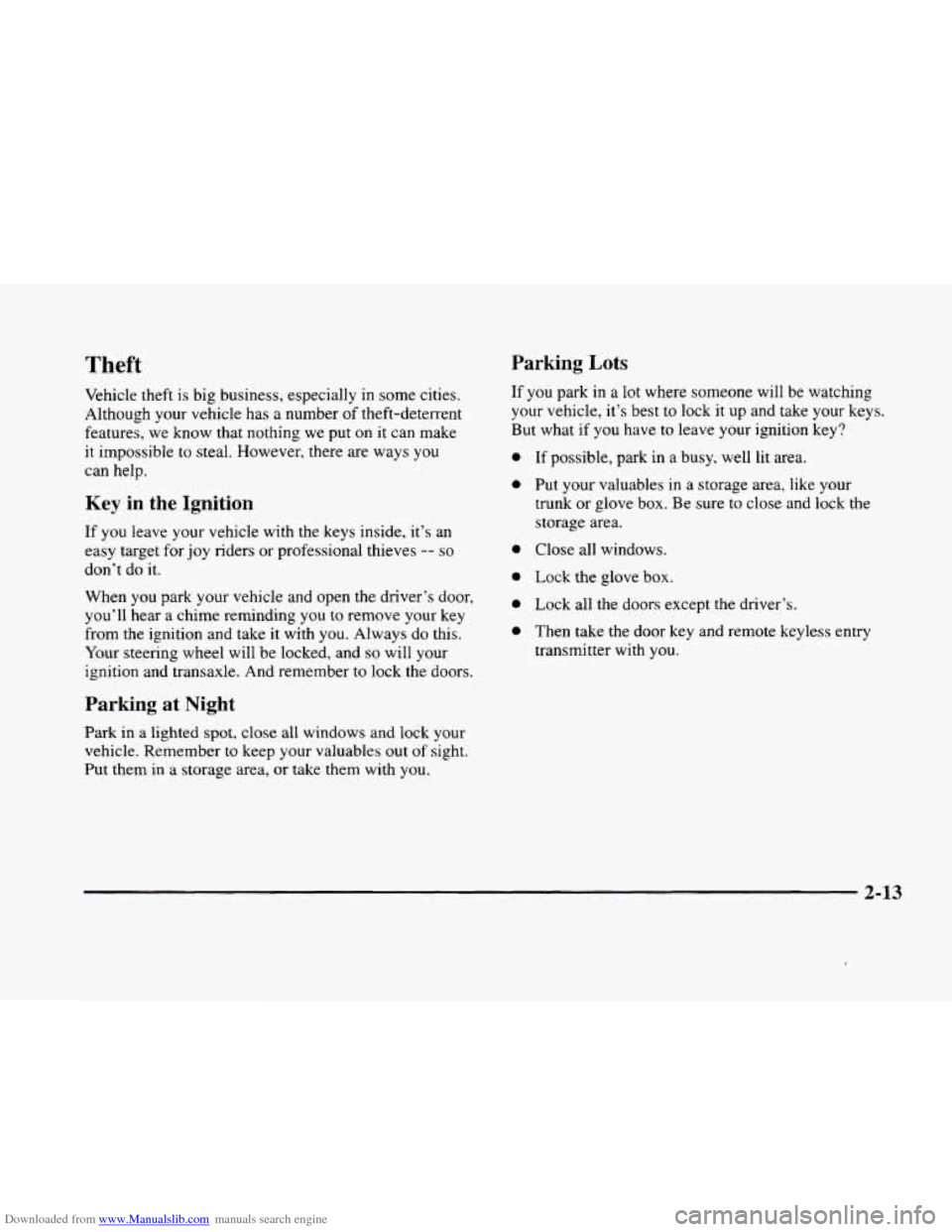
Downloaded from www.Manualslib.com manuals search engine Theft Parking Lots
Vehicle theft is big business, especially in some cities.
Although your vehicle has a number of theft-deterrent
features, we know that nothing we put on it can make
it impossible to steal. However, there are ways
you
can help.
Key in the Ignition
If you leave your vehicle with the keys inside, it’s an
easy target for joy riders or professional thieves
-- so
don’t do it.
When
you park your vehicle and open the driver’s door,
you’ll hear a chime reminding
you to remove your key
from the ignition and take it with
you. Always do this.
Your steering wheel will be locked, and
so will your
ignition and transaxle. And remember
to lock the doors.
Parking at Night
Park in a lighted spot, close all windows and lock your
vehicle. Remember to keep your valuables out of sight.
Put them in a storage area, or take them with you. If
you park in a lot where someone will be watching
your vehicle, it’s best to lock it up and take
your keys.
But what if you have to leave your ignition key?
e
e
If possible, park in a busy, well lit area.
Put your valuables in a storage area, like your
trunk
or glove box. Be sure to close and lock the
storage area.
Close all windows.
Lock the glove box.
Lock all the doors except the driver’s.
Then take the door key and remote keyless entry
transmitter with you.
2-13